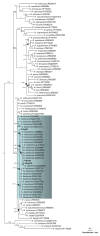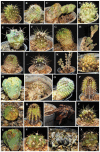Fusarium and Neocosmospora Species Associated with Rot of Cactaceae and Other Succulent Plants
- PMID: 35448595
- PMCID: PMC9024871
- DOI: 10.3390/jof8040364
Fusarium and Neocosmospora Species Associated with Rot of Cactaceae and Other Succulent Plants
Abstract
Infections by Fusarium and Fusarium-like species on cacti and other succulent plants cause the syndrome known as Fusarium dry rot and soft rot. There are only few records of Fusarium species as pathogens of cacti and other succulent plants from Iran. The objective of this study was the identification and characterization of fusarioid species recovered from ornamental succulents in Shiraz County, Iran. Three fusarioid species, including F. oxysporum, F. proliferatum, and Neocosmospora falciformis (formerly F. falciforme), were recovered from 29 diverse species of cacti and other succulents with symptoms of Fusarium dry rot and soft rot. The three fungal species were identified on the basis of morphological characters and the phylogenetic analysis of the translation elongation factor1-α (tef1) nuclear gene. The F. oxysporum isolates were identified as F. oxysporum f. sp. opuntiarum. The pathogenicity of the three fusarioid species was tested on a range of economically important ornamental succulents, mostly in the Cactaceae family. The three species showed a broad host spectrum and induced different types of symptoms on inoculated plants, including soft and dry rot, chlorosis, necrotic spots, wilt, drying, root and crown rot. This is the first report of N. falciformis as a pathogen of succulent plants worldwide.
Keywords: Cactaceae; Fusarium oxysporum f. sp. opuntiarum; Fusarium proliferatum; Nectriaceae; Neocosmospora falciformis; cross-inoculations; host range; pathogenicity; phylogenetic analysis; tef1 gene.
Conflict of interest statement
The authors declare no conflict of interest. The funders had no role in the design of the study; in the collection, analyses, or interpretation of data; in the writing of the manuscript, or in the decision to publish the results.
Figures






Similar articles
-
First Report of Stem Wilt and Root Rot of Schlumbergera truncata Caused by Fusarium oxysporum f. sp. Opuntiarum in Southern Italy.Plant Dis. 2013 Jun;97(6):846. doi: 10.1094/PDIS-11-12-1092-PDN. Plant Dis. 2013. PMID: 30722611
-
Fusarium: more than a node or a foot-shaped basal cell.Stud Mycol. 2021 Aug 17;98:100116. doi: 10.1016/j.simyco.2021.100116. eCollection 2021 Apr. Stud Mycol. 2021. PMID: 34466168 Free PMC article.
-
Characterization of Fusarium and Neocosmospora Species Associated With Crown Rot and Stem Canker of Pistachio Rootstocks in California.Plant Dis. 2019 Aug;103(8):1931-1939. doi: 10.1094/PDIS-11-18-2012-RE. Epub 2019 Jun 12. Plant Dis. 2019. PMID: 31188738
-
Molecular Variability of the Fusarium solani Species Complex Associated with Fusarium Wilt of Melon in Iran.J Fungi (Basel). 2023 Apr 18;9(4):486. doi: 10.3390/jof9040486. J Fungi (Basel). 2023. PMID: 37108940 Free PMC article.
-
First Report of Fusarium proliferatum Causing Root Rot on Soybean (Glycine max) in the United States.Plant Dis. 2011 Oct;95(10):1316. doi: 10.1094/PDIS-04-11-0346. Plant Dis. 2011. PMID: 30731665
Cited by
-
Interaction Between Glycoside Hydrolase FsGH28c from Fusarium solani and PnPUB35 Confers Resistance in Piper nigrum.Int J Mol Sci. 2025 Apr 28;26(9):4189. doi: 10.3390/ijms26094189. Int J Mol Sci. 2025. PMID: 40362427 Free PMC article.
-
Stilbocrea banihashemiana sp. nov. a New Fungal Pathogen Causing Stem Cankers and Twig Dieback of Fruit Trees.J Fungi (Basel). 2022 Jun 30;8(7):694. doi: 10.3390/jof8070694. J Fungi (Basel). 2022. PMID: 35887450 Free PMC article.
-
Characterization and Identification of Neocosmospora solani and Fusarium oxysporum Causing Root Necrosis and Wilting of Orange Trees in Chile.Plants (Basel). 2025 Jan 26;14(3):376. doi: 10.3390/plants14030376. Plants (Basel). 2025. PMID: 39942938 Free PMC article.
-
Molecular and Pathogenic Characterization of Fusarium Species Associated with Corm Rot Disease in Saffron from China.J Fungi (Basel). 2022 May 17;8(5):515. doi: 10.3390/jof8050515. J Fungi (Basel). 2022. PMID: 35628770 Free PMC article.
-
Phylogenomic, Morphological, and Phylogenetic Evidence Reveals Five New Species and Two New Host Records of Nectriaceae (Hypocreales) from China.Biology (Basel). 2025 Jul 17;14(7):871. doi: 10.3390/biology14070871. Biology (Basel). 2025. PMID: 40723428 Free PMC article.
References
-
- Eggli U. Illustrated Handbook of Succulent Plants: Dicotyledons. Springer; Berlin/Heidelberg, Germany: 2004. pp. 1–3.
-
- Albers F., Meve U. Asclepiadaceae. In: Albers F., Meve U., editors. Illustrated Handbook of Succulent Plants: Aizoaceae A–E. Springer; Berlin/Heidelberg, Germany: 2002. pp. 5–8.
-
- Hartmann K.E.K. Aizoaceae. In: Hartmann K.E.K., editor. Illustrated Handbook of Succulent Plants: Aizoaceae A–E. Springer; Berlin/Heidelberg, Germany: 2002. pp. 9–268.
-
- Eggli U. Crassulaceae. In: Eggli U., editor. Illustrated Handbook of Succulent Plants: Crassulaceae. Springer; Berlin/Heidelberg, Germany: 2003. pp. 5–8.
-
- Charles G. Cacti and Succulents: An Illustrated Guide to the Plants and Their Cultivation. Crowood Press; Ramsbury, UK: 2014. 192p
LinkOut - more resources
Full Text Sources

